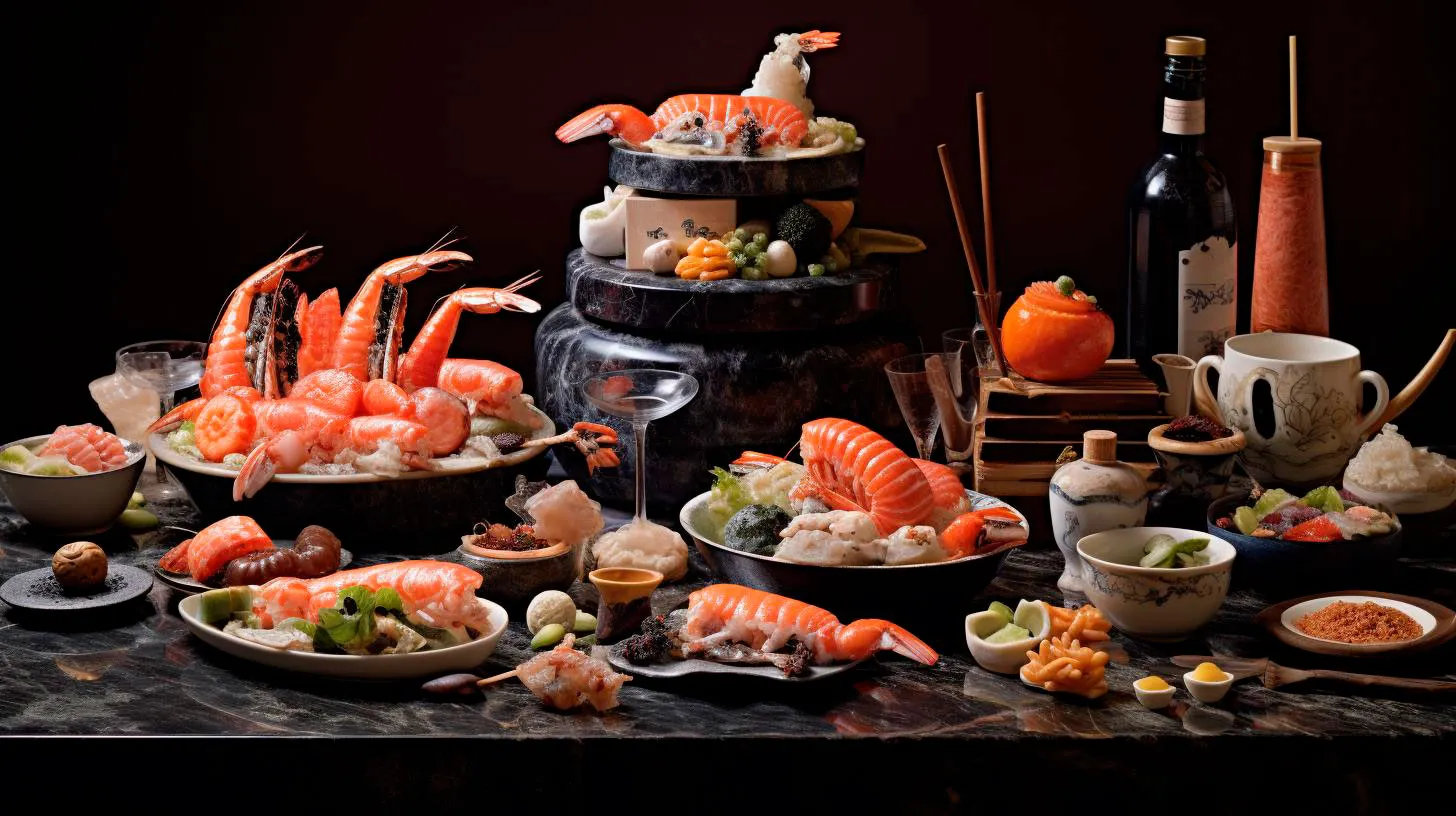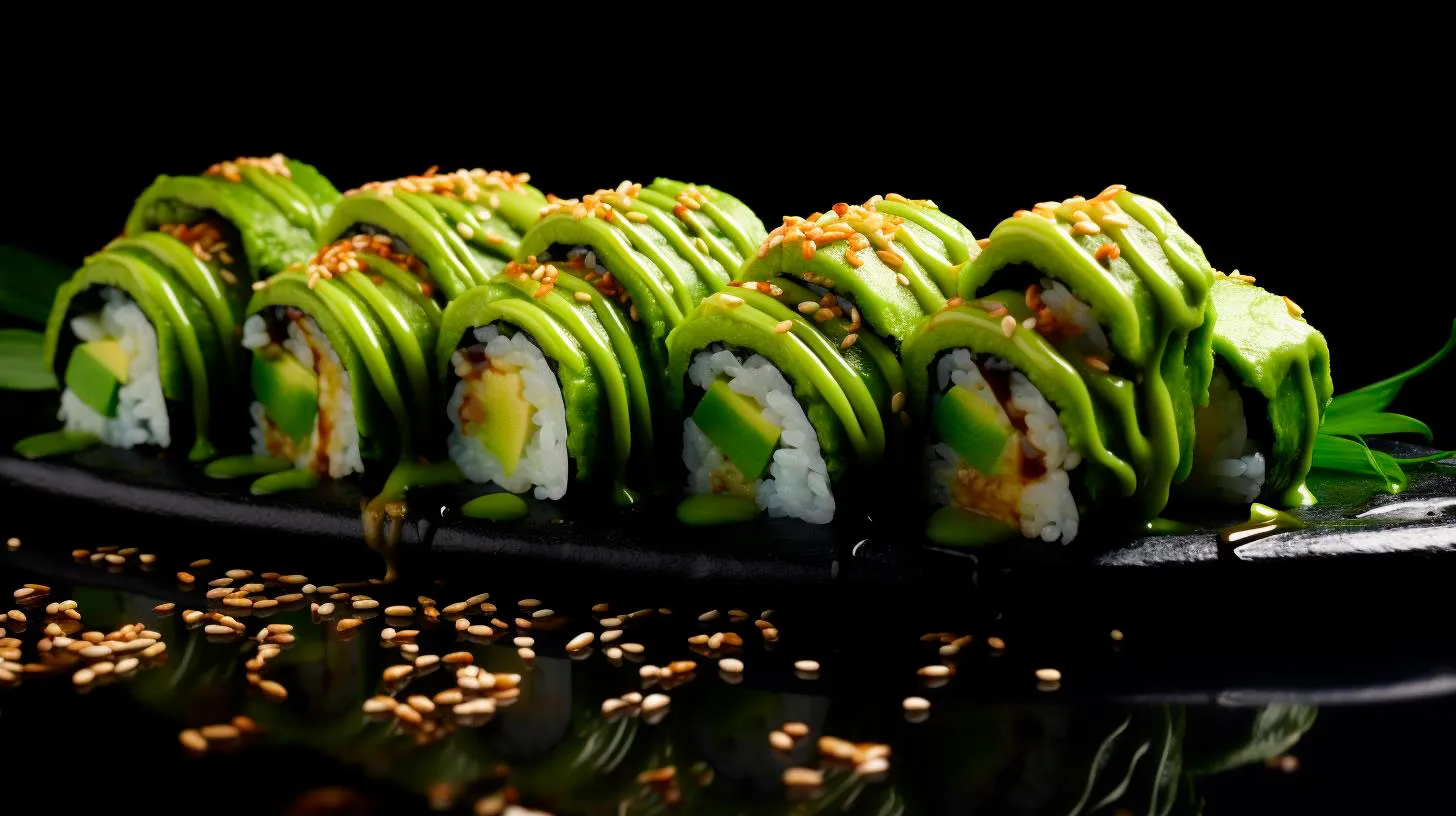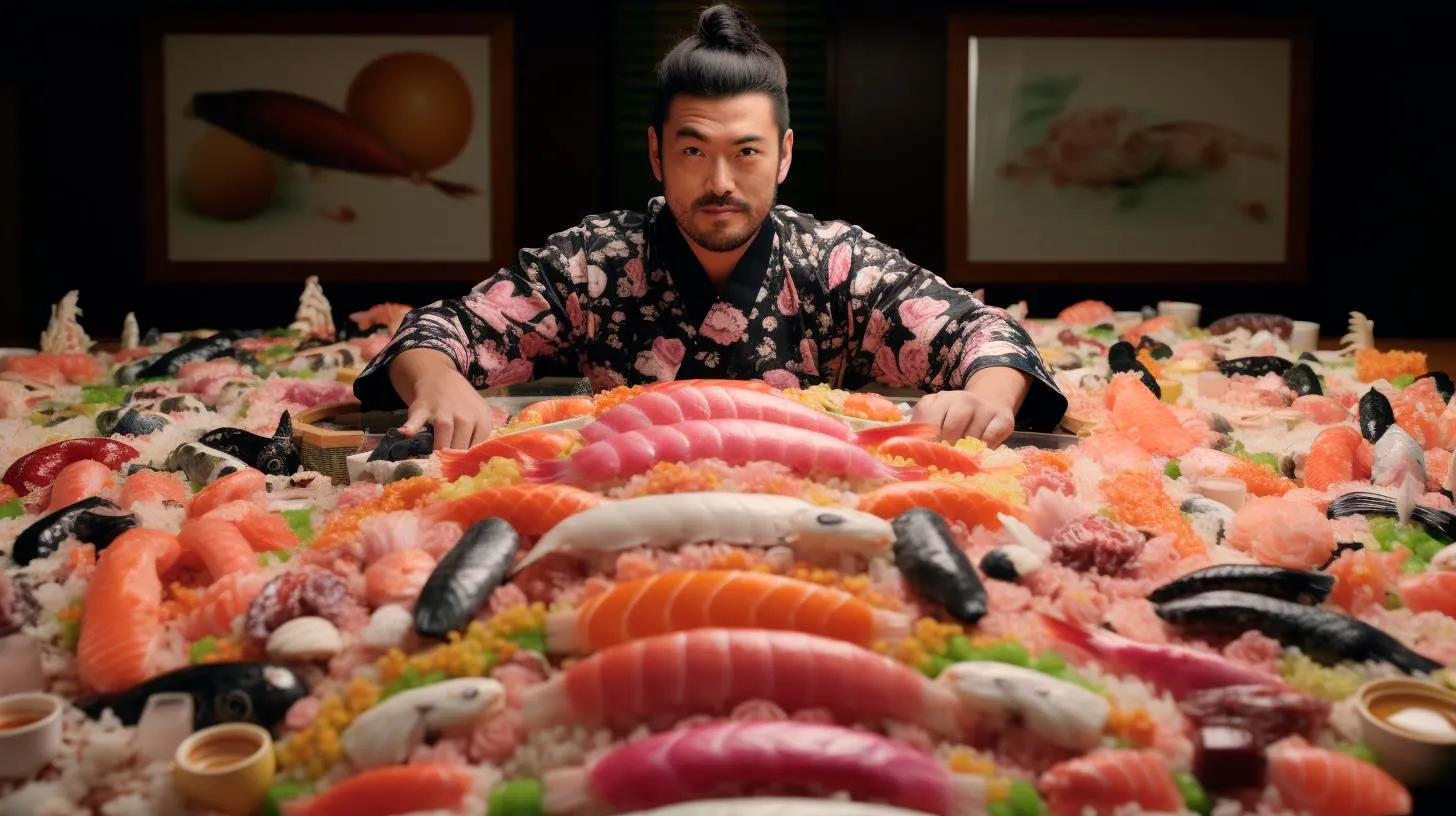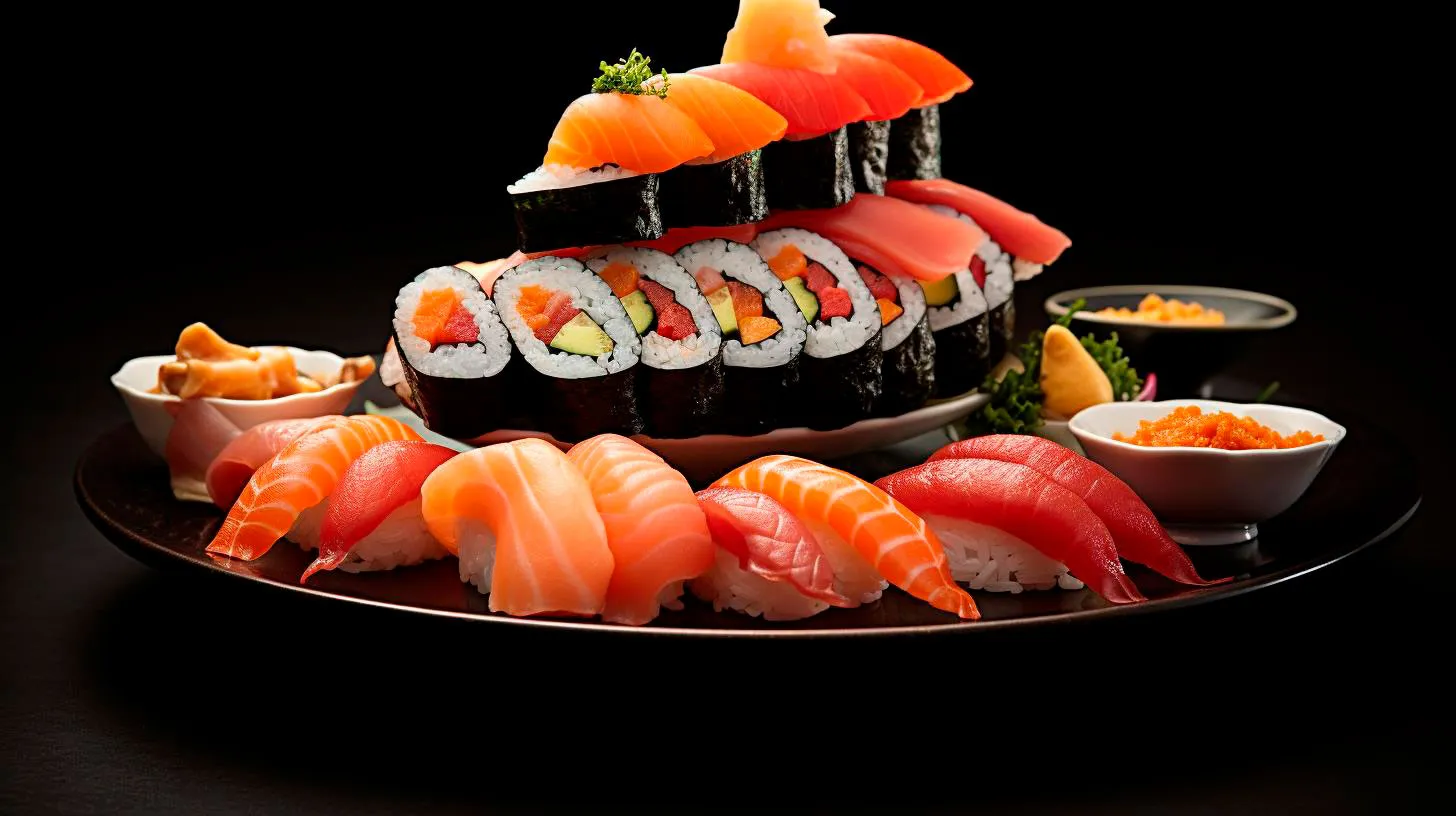Tobiko and Masago: Adding a Pop of Color and Texture to Your Sushi Experience
In this article, we will explore the world of tobiko and masago, their unique characteristics, and how they can elevate your sushi game.
1. Tobiko: Tiny, Bursting Flavor Bombs
Tobiko, also known as “flying fish roe,” is a popular sushi topping that comes in vibrant colors ranging from orange and red to black and green. These tiny, glossy beads resemble caviar and bring a delightful pop of color to your sushi rolls. Tobiko is usually harvested from the flying fish found in the waters of East Asia and is highly prized for its mild, crunchy texture and distinctive flavor.
Key takeaways about tobiko:
- Tobiko adds a visually stunning element to your sushi rolls with its vibrant colors.
- It offers a burst of flavor and adds a pleasant, crunchy texture to your sushi.
- Tobiko is sourced from flying fish and is a popular ingredient in Japanese cuisine.
- It is available in various flavors, including wasabi, yuzu, and spicy.
According to industry statistics, Japan is the leading producer of tobiko, exporting over 800 metric tons of the delicacy each year.
2. Masago: A Delicate Touch of Texture
Masago, often referred to as “capelin roe,” is another sushi topping that captivates sushi enthusiasts with its vibrant appearance and delicate texture. With its tiny, orange beads, masago adds an elegant touch to your sushi rolls. Unlike tobiko, masago is sourced from capelin, a small fish found in the Arctic and Atlantic oceans.
Key takeaways about masago:
- Masago lends a touch of sophistication to your sushi rolls with its delicate and vibrant appearance.
- The texture of masago is slightly smaller and less pronounced than tobiko.
- It has a mild and slightly briny flavor that complements the overall sushi experience.
- Masago is known for its nutritional benefits as it is rich in omega-3 fatty acids and protein.
The demand for masago is steadily increasing, with the global market for capelin roe projected to reach $815 million by 2027, according to recent market research.
3. Elevate Your Sushi Experience with Tobiko and Masago
Now that you have a grasp of tobiko and masago, it’s time to explore how these toppings can take your sushi experience to new heights. Whether you’re a sushi connoisseur or a newbie, adding tobiko and masago to your rolls will undoubtedly impress your taste buds and elevate the presentation of your dish. Here are some key reasons to give them a try:
- Eye-catching presentation: Both tobiko and masago contribute to the visual appeal of your sushi, making it a feast for the eyes.
- Unique flavor profiles: Tobiko’s bursting flavor and masago’s subtle brininess add an extra dimension to your sushi taste experience.
- Pleasurable texture: The crunchy texture of tobiko and the delicate pop of masago create a satisfying and enjoyable mouthfeel.
- Nutritional benefits: Along with their visual and flavor attributes, tobiko and masago are also packed with essential nutrients, such as omega-3 fatty acids and protein.
- Variety and versatility: With flavored tobiko and masago options available, you can customize your sushi rolls to suit your taste preferences.
As you explore the vast world of sushi, don’t forget to experiment with these delightful toppings to enhance both the taste and presentation of your rolls.
The Final Word
Tobiko and masago bring a pop of color, texture, and flavor to your sushi experience. With their vibrant appearance, burst of flavor, and pleasing texture, they are the perfect additions to elevate your sushi game. So, don’t hesitate to explore the world of tobiko and masago and unleash your creativity by adding these exquisite toppings to your next sushi adventure.
Delight your Taste Buds Discovering the Flavorful Delicacies of Tobiko and Masago
If you’re looking to explore new flavors and elevate your dishes, look no further than these delightful delicacies.
What is Tobiko?
Tobiko is the roe or eggs of the flying fish, which is native to the waters of Japan. It is known for its vibrant colors, which can range from bright red and orange to golden and black. The small, crunchy eggs burst with a burst of flavor, adding a distinctive sweetness and hint of saltiness to any dish.
- Size: Tobiko eggs are small, about the size of a grain of rice.
- Flavor: Tobiko has a naturally sweet and slightly salty taste.
- Color Varieties: Tobiko comes in a variety of colors including red, orange, golden, and black.
- Usage: Tobiko is commonly used to garnish sushi, sashimi, and other seafood dishes.
Discovering the Magic of Masago
Similar to tobiko, masago is another type of fish roe that originates from capelin, a small fish found in the North Atlantic and Arctic oceans. It boasts a beautiful orange color and a slightly smaller size compared to tobiko. Masago adds a burst of flavor and a delicate texture to dishes, making it a favorite among sushi lovers and Asian cuisine enthusiasts.
- Size: Masago eggs are slightly smaller compared to tobiko.
- Flavor: Masago has a subtle briny flavor, which enhances the taste of the dish.
- Color: Masago is typically orange in color.
- Usage: Masago is commonly used in sushi rolls, poke bowls, and salads.
Pairing Tobiko and Masago with Dishes
Tobiko and masago can elevate the flavor and appearance of a variety of dishes. Their vibrant colors and unique texture make them an excellent choice for garnishing and adding a delightful pop in every bite. Here are some ways to incorporate these delectable delicacies:
Sushi Rolls:
Both tobiko and masago are widely used in sushi rolls, offering a burst of flavor with each bite. Whether you’re a fan of traditional rolls or prefer creative combinations, topping your sushi rolls with tobiko or masago is a sure way to enhance the overall taste and presentation of the dish.
Poke Bowls:
Poke bowls have gained immense popularity in recent years, and tobiko and masago are among the top choices for toppings. The crunchy texture and briny flavor of these fish roes complement the fresh seafood and vegetables in a poke bowl, creating a harmonious blend of flavors.
Seafood Pasta:
If you enjoy seafood pasta dishes, sprinkle some tobiko or masago on top to take it to the next level. The roe adds a burst of umami flavor and a deliciously satisfying crunch to the pasta, creating an unforgettable dining experience.
Key Takeaways
Tobiko and masago are versatile ingredients that can enhance the taste, texture, and visual appeal of various dishes. Here are the key takeaways from discovering these flavorful delicacies:
- Tobiko and masago are fish roes that add a burst of flavor to dishes.
- Tobiko comes in vibrant colors like red, orange, golden, and black, while masago is typically orange.
- Both tobiko and masago have a slightly salty taste, enhancing the overall flavor profile of a dish.
- These delicacies are commonly used in sushi rolls, poke bowls, and seafood pasta.
- Adding tobiko or masago to your dishes can elevate the dining experience and impress your guests.
Exploring the world of tobiko and masago opens up a world of culinary possibilities. The unique flavors and delightful texture of these fish roes make them a must-try for any food enthusiast. Whether you’re a sushi lover, seafood fanatic, or simply someone looking to elevate their cooking skills, tobiko and masago are sure to dazzle your taste buds and leave you craving for more.
Tobiko vs Masago: Unraveling the Distinct Characteristics of Sushi Colorful Gems
In this article, we will unravel the distinct characteristics of tobiko and masago, exploring their differences, benefits, and how they are used in sushi creations.
What is Tobiko?
Tobiko are small, vibrant orange beads, commonly used in traditional sushi rolls. They are produced from the roe of flying fish, primarily found in Japan and Southeast Asia. Tobiko is celebrated for its crunchy texture, creating a delightful popping sensation in your mouth.
Distinct Characteristics of Tobiko:
- Jewel-like appearance adds visual appeal to sushi rolls
- Packed with essential nutrients, including vitamins and minerals
- Crunchy texture enhances the overall sushi experience
One of the significant advantages of tobiko is its natural orange color that can brighten up any sushi roll, making it visually appealing. Additionally, tobiko contains a considerable amount of vitamins and minerals, including omega-3 fatty acids, which are beneficial for heart health. The crunchy texture of tobiko adds an exciting contrast to the sushi, elevating your taste buds’ experience.
What is Masago?
Similar to tobiko, masago is also fish roe used in sushi preparations. However, unlike tobiko, masago comes from the roe of capelin fish, found in the cold waters of the North Atlantic. Masago has a smaller size compared to tobiko and is available in various colors, including red, orange, and black.
Distinct Characteristics of Masago:
- Vibrant colors provide versatility in sushi presentation
- Delicate and subtle taste adds a hint of flavor to sushi rolls
- Used in a wide range of sushi dishes
One of the significant advantages of masago is its versatility in presentation. With its vibrant shades of red, orange, and black, masago is often used to create visually stunning sushi rolls. Masago has a delicate and subtle taste, lending a pleasant hint of flavor to the sushi. Due to its versatility, you can find masago in various sushi dishes, including nigiri, gunkan maki, and temaki.
Tobiko vs. Masago: Key Takeaways
Now that we have explored the distinct characteristics of tobiko and masago, let’s summarize the key takeaways:
- Tobiko, made from flying fish roe, offers a crunchy texture and jewel-like appearance, brightening up sushi rolls.
- Tobiko is packed with essential nutrients, including omega-3 fatty acids, benefiting heart health.
- Masago, sourced from capelin fish roe, provides versatility in presentation due to its vibrant colors.
- Masago adds a subtle flavor to sushi, enhancing the overall taste profile.
- Both tobiko and masago are widely used in various sushi creations, adding visual appeal and flavor.
When it comes to choosing between tobiko and masago, it ultimately comes down to personal preference. Some individuals enjoy the crunchy burst of tobiko, while others prefer the delicate taste and versatility of masago. Regardless of your choice, incorporating these colorful fish roe in your sushi rolls will undoubtedly elevate your dining experience.
Next time you find yourself indulging in sushi, remember to appreciate the distinct characteristics that tobiko and masago bring to this delightful culinary art. Enjoy the vibrant colors, revel in the delightful bursts of flavors, and savor every bite of these sushi colorful gems!
Tobiko and Masago: Exploring the Vibrant Stars of Sushi
In this article, we will dive deeper into the world of tobiko and masago, exploring their origins, nutritional benefits, and how they enhance your sushi experience.
1. Tobiko – A Touch of Brilliance
Tobiko, the roe of flying fish, originates from Japan and is known for its exceptionally bright colors. The tiny eggs are typically dyed to enhance their visual appeal, with common shades including red, orange, black, and green. These vibrant colors not only elevate the aesthetic beauty of sushi but also reflect different flavors and textures.
- Crunchy Texture: Unlike other roe varieties, tobiko eggs have a satisfying, crunchy texture that adds an exciting contrast to the soft rice and smooth fish in sushi rolls.
- Flavor Explosion: Tobiko is lightly salty with a burst of oceanic flavors. It is often seasoned with soy sauce, wasabi, or other ingredients to intensify its taste.
- Nutritional Boost: Just a spoonful of tobiko can provide you with a significant amount of protein, essential omega-3 fatty acids, and various vitamins and minerals.
When enjoying sushi that incorporates tobiko, take a moment to appreciate the visual appeal, delightful crunch, and burst of flavors that this colorful roe brings to your palate.
2. Masago – A Delicate Sensation
Similar to tobiko, masago is another type of fish roe frequently used in sushi preparation. It comes from the roe of capelin fish and is characterized by its smaller size and slightly milder taste compared to tobiko. Masago is typically available in shades of orange and has a more translucent appearance.
- Tender Texture: The eggs of masago have a delicate and tender texture that gently dissolves in your mouth, creating a smooth and harmonious eating experience.
- Subtle Flavor: Masago has a mild and subtle taste, allowing it to complement the other ingredients in sushi. It adds a gentle hint of umami and a touch of saltiness to each bite.
- Rich in Nutrients: Masago is packed with essential nutrients such as vitamins A, B12, and D, as well as omega-3 fatty acids, contributing to a well-rounded and healthy diet.
The addition of masago to sushi not only enhances the taste but also brings a delightful texture and a touch of elegance to every roll.
Key Takeaways
Both tobiko and masago contribute to the overall sushi experience, elevating it to an art form. By incorporating these tiny treasures into your sushi rolls, you can expect:
- An explosion of flavors and textures
- Visual appeal and vibrant aesthetics
- Nutritional benefits, including protein and essential vitamins
- A well-rounded sushi experience with a harmonious balance of tastes
Sushi, with its remarkable variety and attention to detail, continues to captivate enthusiasts around the world. The addition of tobiko and masago takes this culinary experience to another level, introducing a delicate symphony of colors, textures, and flavors. Explore the vibrant stars of sushi and let tobiko and masago elevate your next sushi indulgence to new heights.



